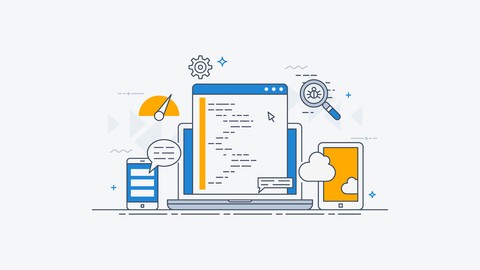
Deep Learning with Python and PyTorch
Deep Learning with Python and PyTorch, available at $44.99, has an average rating of 3.93, with 44 lectures, 2 quizzes, based on 7 reviews, and has 56 subscribers.
You will learn about Create neural networks to predict the demand for airline travel in the future Identify negative tweets on Twitter by using Convolutional Neural Networks (CNN's) Create a neural network which will identify smiles in your camera app Forecast a company's stock prices for the next day using deep learning models Learn intuitive ways to build neural networks using the PyTorch API Master PyTorch’s unique features gradually as you work through projects that make PyTorch perfect for rapid prototyping Debug your PyTorch code using standard Python tools, so you can easily fix bugs This course is ideal for individuals who are This course is for Python programmers, Data Science professionals who would like to practically implement Python and PyTorch and exploit its unique features in their deep learning projects. It is particularly useful for This course is for Python programmers, Data Science professionals who would like to practically implement Python and PyTorch and exploit its unique features in their deep learning projects.
Enroll now: Deep Learning with Python and PyTorch
Summary
Title: Deep Learning with Python and PyTorch
Price: $44.99
Average Rating: 3.93
Number of Lectures: 44
Number of Quizzes: 2
Number of Published Lectures: 44
Number of Published Quizzes: 2
Number of Curriculum Items: 46
Number of Published Curriculum Objects: 46
Original Price: $199.99
Quality Status: approved
Status: Live
What You Will Learn
- Create neural networks to predict the demand for airline travel in the future
- Identify negative tweets on Twitter by using Convolutional Neural Networks (CNN's)
- Create a neural network which will identify smiles in your camera app
- Forecast a company's stock prices for the next day using deep learning models
- Learn intuitive ways to build neural networks using the PyTorch API
- Master PyTorch’s unique features gradually as you work through projects that make PyTorch perfect for rapid prototyping
- Debug your PyTorch code using standard Python tools, so you can easily fix bugs
Who Should Attend
- This course is for Python programmers, Data Science professionals who would like to practically implement Python and PyTorch and exploit its unique features in their deep learning projects.
Target Audiences
- This course is for Python programmers, Data Science professionals who would like to practically implement Python and PyTorch and exploit its unique features in their deep learning projects.
Are you ready to go on a journey into the world of deep learning with the powerful Python and PyTorch? This course will be your guide through the joys and dangers of this new wave of machine learning.
Python is quickly becoming the technology of choice for deep learning and machine learning, because of its ease to develop powerful neural networks and intelligent machine learning applications. Like Python, PyTorch has a clean and simple API, which makes building neural networks faster and easier. It’s also modular, and that makes debugging your code a breeze.
This comprehensive 2-in-1 course will teach you deep learning with Python and PyTorch in an easy-to-understand, practical manner with the help of use cases based on real-world datasets. To begin with, you will create neural networks and deep learning models to predict data and to solve some problems based on the scenarios in the use cases. Next, you will learn how to use Convolutional Neural Networks (CNNs) to classify images, Recurrent Neural Networks (RNNs) to detect languages, and then translate them using Long-Term-Short Memory (LTSM). Finally, you will learn to create Deep Neural Network (DNN) to paint unique images.
Contents and Overview
This training program includes 2 complete courses, carefully chosen to give you the most comprehensive training possible.
In the first course, Real-World Python Deep Learning Projects, you will start of by creating neural networks to predict the demand for airline travel in the future. You will then run through a scenario where you have to identify negative tweets for a celebrity by using Convolutional Neural Networks (CNN’s). Next, you will create a neural network which will be able to identify smiles in your camera app. Finally, the last project will help you forecast a company’s stock prices for the next day using deep learning.
In the second course, Deep Learning Adventures with PyTorch, you will start by using Convolutional Neural Networks (CNNs) to classify images; Recurrent Neural Networks (RNNs) to detect languages; and then translate them using Long-Term-Short Memory (LTSM). Finally, you will channel your inner Picasso by using Deep Neural Network (DNN) to paint unique images.
By the end of this course, you will be ready to use Python and PyTorch proficiently in your real-world deep learning projects.
Meet Your Expert(s):
We have the best work of the following esteemed author(s) to ensure that your learning journey is smooth:
Jakub Konczyk has enjoyed programming professionally since 1995. He is a Python and Django expert and has been involved in building complex systems since 2006. He loves to simplify and teach programming subjects and share them with others. He first discovered Machine Learning when he was trying to predict real estate prices in one of the early stage startups he was involved in. He failed miserably. Then he discovered a much more practical way to learn Machine Learning, which he would like to share with you in this course. It boils down to the Keep it simple! mantra.
Course Curriculum
Chapter 1: Real-World Python Deep Learning Projects
Lecture 1: The Course Overview
Lecture 2: What Types of Problems Can You Solve Using Deep Learning?
Lecture 3: Installing Essential DL Tools
Lecture 4: Based on Past Data, Predicting the Number of Airline Passengers
Lecture 5: Getting and Preparing Airline Data
Lecture 6: Building Your Multilayer Perceptron Model
Lecture 7: Training and Testing Your Model
Lecture 8: Making Predictions and What's Next?
Lecture 9: End Goal – Label a Given Tweet (Short Text) as Negative or Positive
Lecture 10: Dataset Overview
Lecture 11: Preparing Data for Sentiment Analysis
Lecture 12: What Are Word Embeddings and Why They Are Important When Working with CNNs?
Lecture 13: Building Your CNN Model for Text Classification
Lecture 14: Training and Testing Your Model
Lecture 15: Detecting Mean Tweets Using Your Model and What’s Next?
Lecture 16: Detect Whether an Image Contains a Smile with High Accuracy
Lecture 17: Getting and Preparing Data for Smile Detection
Lecture 18: Building Your CNN Model for Smile Detection.
Lecture 19: Training and Testing Your Model
Lecture 20: Detecting Smiles with Your Model and What’s Next?
Lecture 21: Predict the Closing Stock Price of a Given Company for the Next Day
Lecture 22: Getting and Preparing Stock Prices Data
Lecture 23: Building Your LSTM Model for Price Prediction
Lecture 24: Training and Testing Your Model
Lecture 25: Detecting Closing Stock Price with Your Model and What’s Next?
Chapter 2: Deep Learning Adventures with PyTorch
Lecture 1: The Course Overview
Lecture 2: What Makes PyTorch Special?
Lecture 3: Installing PyTorch
Lecture 4: Problem: Detect a Specific Type of Object in an Image
Lecture 5: Quick Win: Using a Pretrained AlexNet Model for Beaver Detection
Lecture 6: Getting and Preparing Image Data
Lecture 7: Building, Training, and Testing Your Model
Lecture 8: Using Your Model to Detect Beavers and What’s Next?
Lecture 9: Problem: Recognize the Language of a Specific Text
Lecture 10: Understanding and Preparing Language Data
Lecture 11: Building, Training, and Testing Your Model for Language Detection
Lecture 12: Using Your Model to Detect Languages and What’s Next?
Lecture 13: Problem: Translate a Specific Text from One Language to Another
Lecture 14: Understanding and Preparing Dataset for Language Translation
Lecture 15: Building, Training, and Testing Your Models for Language Translation
Lecture 16: Using Your Models for Language Translation
Lecture 17: Problem: Extract Key Style Features from One Image and Use It on Another One
Lecture 18: Preparing Images for Style Transfer
Lecture 19: Building and Training Style Transfer Model
Instructors
-
Packt Publishing
Tech Knowledge in Motion
Rating Distribution
- 1 stars: 1 votes
- 2 stars: 0 votes
- 3 stars: 1 votes
- 4 stars: 3 votes
- 5 stars: 2 votes
Frequently Asked Questions
How long do I have access to the course materials?
You can view and review the lecture materials indefinitely, like an on-demand channel.
Can I take my courses with me wherever I go?
Definitely! If you have an internet connection, courses on Udemy are available on any device at any time. If you don’t have an internet connection, some instructors also let their students download course lectures. That’s up to the instructor though, so make sure you get on their good side!
You may also like
- Best Public Speaking Courses to Learn in March 2025
- Best Affiliate Marketing Courses to Learn in March 2025
- Best Email Marketing Courses to Learn in March 2025
- Best Social Media Management Courses to Learn in March 2025
- Best SEO Optimization Courses to Learn in March 2025
- Best Content Creation Courses to Learn in March 2025
- Best Game Development Courses to Learn in March 2025
- Best Software Testing Courses to Learn in March 2025
- Best Big Data Courses to Learn in March 2025
- Best Internet Of Things Courses to Learn in March 2025
- Best Quantum Computing Courses to Learn in March 2025
- Best Cloud Computing Courses to Learn in March 2025
- Best 3d Modeling Courses to Learn in March 2025
- Best Mobile App Development Courses to Learn in March 2025
- Best Graphic Design Courses to Learn in March 2025
- Best Videography Courses to Learn in March 2025
- Best Photography Courses to Learn in March 2025
- Best Language Learning Courses to Learn in March 2025
- Best Product Management Courses to Learn in March 2025
- Best Investing Courses to Learn in March 2025






















